
- •Стоматологічний факультет курс і структура залікового кредиту - модуля 1:
- •Інтродуктивний.
- •Active Vocabulary
- •Our classes – наші заняття
- •Active Vocabulary:
- •Pay attention how names of these medical specialists are formed:
- •Odessa state medical university
- •My future profession – професія, яку я обираю
- •Hippocrates - гіппократ
- •Hippocrates.
- •Grammar Past Simple
- •Nikolay ivanovich pirogov
- •In 1840 Pirogov took up an appointment as professor of surgery at the academy of military medicine in Saint Petersburg.
- •Intravenous administration внутрішньовенне призначення
- •Who (world health organization)
- •International officers working in who are stationed … headquarters … Geneva… Regional offices.
- •At the Pharmacy
- •Systems of the body
- •The skeleton - скелет
- •Human body
- •B o n e s , m u s c l e s , j o I n t s - кістки, суглоби, м’язи
- •Bones, muscles, joints.
- •Lesson 18. Tissues
- •C e l l s - клітини
- •E n d o c r I n e g l a n d s – ендокринні залози
- •Endocrine glands
- •Microbiology - мікробіологія
- •Microorganisms
- •Robert Koch – Роберт Кох
- •Can, must, should, could, be able to, might, need, have to
- •Fleming (centre) receiving the Nobel Prize from King Gustaf Vof Sweden (right), 1945
- •In 1942 Fleming tried his own first experiment. A friend of his was very ill, dying. After several injections of penicillin the man was cured. It marked the beginning of penicillin treatment.
- •The Heart - Серце
- •Iron залізо To facilitate сприяти, полегшувати
- •Haemoglobin
- •Minerals - Мінерали
- •The oral cavity - ротова порожнина
- •Anatomy of a tooth - анатомія зуба
- •Sets of teeth - набір зубів
- •Sets of teeth
- •Dental formulas
- •I (to suffer) never from such a horrible headache.
- •Modern Stomatology - Сучасна стоматологія
- •Stomatological polyclinic – стоматологічна поліклініка
- •At the dental surgery
- •Oral hygiene - гігієна ротової порожнини
- •Oral hygiene and the prevention of dental disease
- •Список використаних джерел
Haemoglobin
Haemoglobin (/hiːməˈɡloʊbɪn/ abbreviated Hb or Hgb) is the protein molecule in red blood cells that carries oxygen from the lungs to the body's tissues and returns carbon dioxide from the tissues to the lungs.
Haemoglobin is made up of four protein molecules (globulin chains) that are connected together. The normal adult hemoglobin (Hbg) molecule contains 2 alpha-globulin chains and 2 beta-globulin chains.
Each globulin chain contains an important central structure called the haeme molecule. Embedded within the haeme molecule is iron that transports the oxygen and carbon dioxide in our blood. The iron contained in haemoglobin is also responsible for the red color of blood.
Haemoglobin also plays an important role in maintaining the shape of the red blood cells. Abnormal haemoglobin structure can, therefore, disrupt the shape of red blood cells and impede its function and its flow through blood vessels.
Hemoglobin is usually measured as a part of the complete blood count (CBC) from a blood sample.
The haemoglobin level is expressed as the amount of haemoglobin in grams (gm) per deciliter (dl) of whole blood, a deciliter being 100 milliliters.
The normal ranges for haemoglobin depend on the age and, beginning in adolescence, the gender of the person. The normal ranges are: Newborns: 17-22 gm/dl, Children: 11-13 gm/dl, Adult males: 14-18 gm/dl, Adult women: 12-16 gm/dl
Low haemoglobin is referred to as anemia. There are many reasons for anemia. Some of the more common causes are: loss of blood, nutritional deficiency (iron, vitamin B12, folate), bone marrow problems, abnormal haemoglobin (sickle cell anemia).
Higher than normal haemoglobin levels can be seen in people living at high altitudes and in people who smoke. Dehydration produces a falsely high haemoglobin which disappears when proper fluid balance is restored.
Sickle cell disease is a genetic condition in which the quality of haemoglobin is defective. This condition can cause abnormal haemoglobin which, in turn, can result in abnormally shaped (sickled) red blood cells. These abnormal red blood cells cannot easily pass through small blood vessels and, therefore, could deprive the body organs of adequate oxygen.
Thalassemia refers to a group of hereditary conditions with quantitative haemoglobin deficiency. The severity of these conditions depends on the type of deficient globulin chain. Mild disease may be only present as mild anemia, whereas, severe deficiency may not be compatible with life.
Exercise 8. Answer the following questions:
How is haemoglobin abbreviated?
What molecules is haemoglobin made up of?
What molecule contains 2 alpha-globulin chains and 2 beta-globulin chains?
What does each globulin chain contain?
What transports the oxygen and carbon dioxide in our blood?
What is also responsible for the red color of blood?
What is an important role of hemoglobin?
How is haemoglobin usually measured?
What does the normal ranges for haemoglobin depend on?
What is a genetic condition in which the quality of haemoglobin is defective?
Exercise 9. Translate the following word combinations into English:
Гемоглобін серпоподібних еритроцитів; позбавляти організм; характерна риса, особливість; вуглекислий газ; таласемія (мішенеподібно-клітинна гемолітична анемія); несумісний з життям; кістковий мозок; генетичний стан; допінг контроль; зневоднення організму; залежити від; вимірювати; генетичний стан; відповідати за; кількісний дефіцит; спадкова хвороба; водний баланс; втрата крові; переносити кисень; підтримувати форму; кисень
Exercise 10. Find the appropriate sentence endings:
Haemoglobin is the protein molecule in red blood cells that carries oxygen from the lungs to the …
Hemoglobin is made up of four protein molecules (globulin chains) that…
Each globulin chain contains an important central structure called …
Embedded within the heme molecule is iron that …
The iron contained in hemoglobin is also responsible for …
Hemoglobin also plays an important role in …
Abnormal hemoglobin structure can disrupt the shape of red blood cells and…
Hemoglobin is usually measured as a part of the complete blood count (CBC) from …
The hemoglobin level is expressed as the amount of hemoglobin in grams per deciliter of whole blood, …
… body's tissues.
… a deciliter being 100 milliliters.
… the red color of blood.
… are connected together.
…impede its function and its flow through blood vessels.
… maintaining the shape of the red blood cells.
…the heme molecule.
… transports the oxygen and carbon dioxide in our blood.
…a blood sample.
Exercise 11. Complete the following sentences with the suitable words from the box:
-
Hemoglobin; dyspnea; itself; consequences; minor; hemorrhage; due to; hemolysis; common; underlying; increasing; deficiency; claudication; report; oxygen; hypoxia; hematopoiesis.
Anemia
Anemia ( /əˈniːmiə/; from Greek meaning lack of blood) is a decrease in number of red blood cells (RBCs) or less than the normal quantity of … in the blood. However, it can include decreased oxygen-binding ability of each hemoglobin molecule … deformity or lack in numerical development as in some other types of hemoglobin … .
Because hemoglobin (found inside RBCs) normally carries … from the lungs to the tissues, anemia leads to … (lack of oxygen) in organs. Because all human cells depend on oxygen for survival, varying degrees of anemia can have a wide range of clinical… .
Anemia is the most … disorder of the blood. There are several kinds of anemia, produced by a variety of … causes. The three main classes of anemia include excessive blood loss (…), excessive blood cell destruction (… ) or deficient red blood cell production (ineffective … ).
Anemia goes undetermined in many people, and symptoms can be … or vague. The signs and symptoms can be related to the anemia… , or the underlying cause.
Most commonly, people with anemia … non-specific symptoms of a feeling of weakness, or fatigue, general malaise and sometimes poor concentration. They may also report … (shortness of breath) on exertion. In very severe anemia, the body may compensate by the lack of oxygen-carrying capability of the blood for… cardiac output. The patient may have symptoms related to this, such as palpitations, angina (if preexisting heart disease is present), intermittent ... of the legs, and symptoms of heart failure.
Exercise 12. Complete the text with the prepositions from the box below and translate it in written form:
-
by; on; in; in; from; of; with; on; of; in
… examination, the signs exhibited may include pallor (pale skin, mucosal linings and nail beds) but this is not a reliable sign. There may be signs … specific causes of anemia, e.g., koilonychia (in iron deficiency), jaundice (when anemia results from abnormal break down of red blood cells — in hemolytic anemia), bone deformities (found in thalassemia major) or leg ulcers (seen in sickle-cell disease).
…severe anemia, there may be signs of a hyperdynamic circulation: tachycardia (a fast heart rate), bounding pulse, flow murmurs, and cardiac ventricular hypertrophy (enlargement). There may be signs of heart failure.
Pica, the consumption of non-food based items such as dirt, paper, wax, grass, ice, and hair, may be a symptom of iron deficiency, although it occurs often in those who have normal levels of hemoglobin.
Chronic anemia may result in behavioral disturbances in children as a direct result … impaired neurological development in infants, and reduced scholastic performance … children of school age.
Restless legs syndrome is more common in those… iron-deficiency anemia.
Less common symptoms may include swelling of the legs or arms, chronic heartburn, vague bruises, vomiting, increased sweating, and blood in stool.
Anemia is typically diagnosed … a complete blood count. Apart … reporting the number of red blood cells and the hemoglobin level, the automatic counters also measure the size of the red blood cells … flow cytometry, which is an important tool in distinguishing between the causes of anemia. Examination of a stained blood smear using a microscope can also be helpful, and is sometimes a necessity… regions of the world where automated analysis is less accessible.
Exercise 13. Put questions to the underlined words.
Treatments for anemia depend on severity and cause.
Mild to moderate iron-deficiency anemia is treated by oral iron supplementation with ferrous sulfate, ferrous fumarate, or ferrous gluconate.
When taking iron supplements, it is very common to experience stomach upset and/or darkening of the feces.
The stomach upset can be alleviated by taking the iron with food; however, this decreases the amount of iron absorbed.
Vitamin C aids in the body's ability to absorb iron, so taking oral iron supplements with orange juice is of benefit.
Vitamin supplements given orally (folic acid) or intramuscularly (vitamin B-12) will replace specific deficiencies.
In anemia of chronic disease, anemia associated with chemotherapy, or anemia associated with renal disease, some clinicians prescribe recombinant erythropoietin, epoetin alfa, to stimulate red-cell production.
In severe cases of anemia, or with ongoing продолжающийся blood loss, a blood transfusion may be necessary.
Several methods existed for measuring hemoglobin, most of which were done currently by automated machines designed to perform several different tests on blood.
Within the machine, the red blood cells are broken down to get the hemoglobin into a solution.
Lungs - Легені
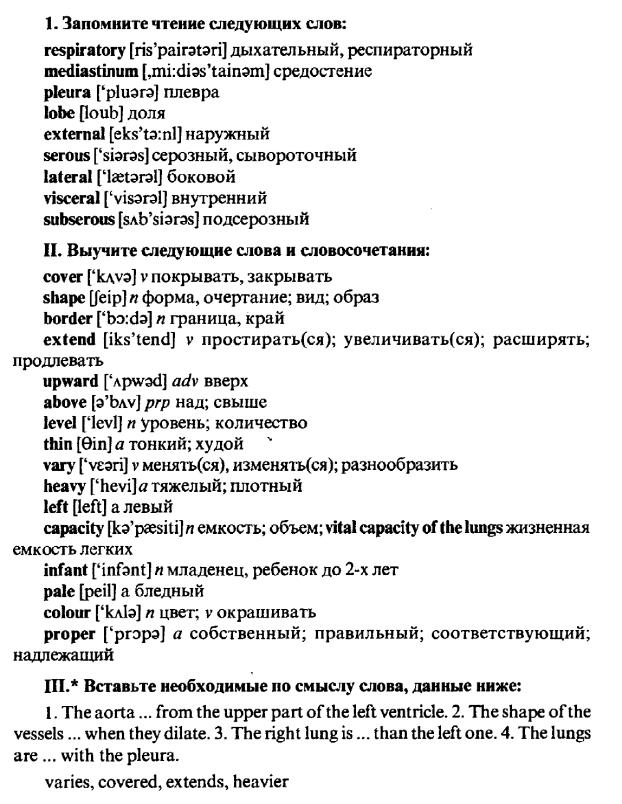
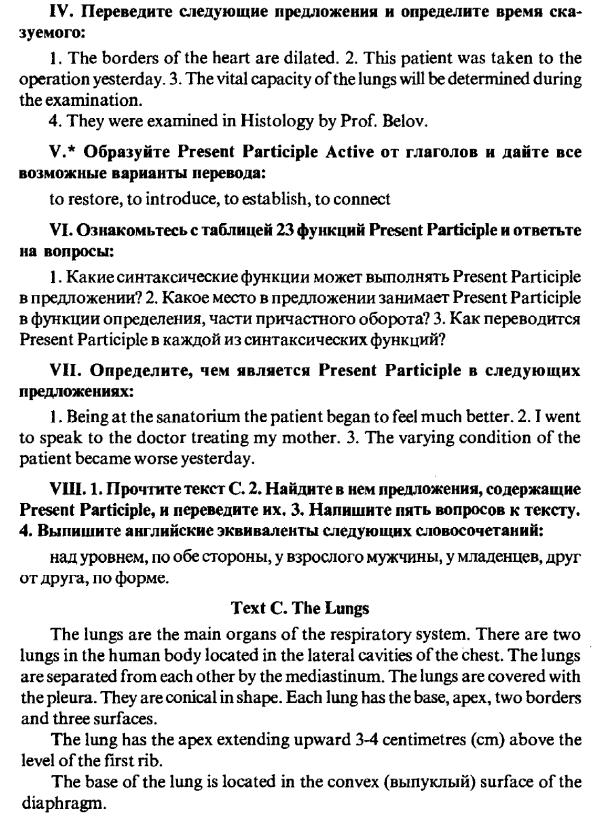
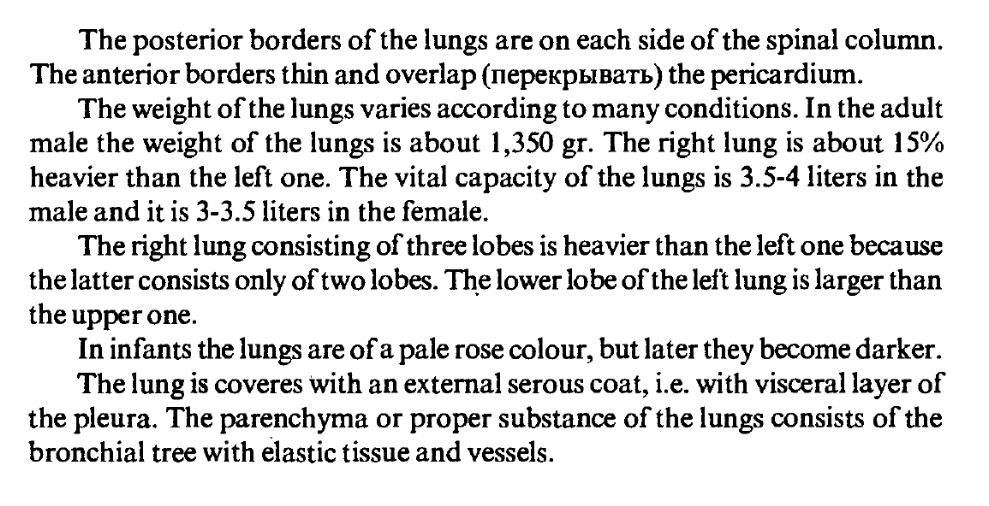
Brain - Головний мозок



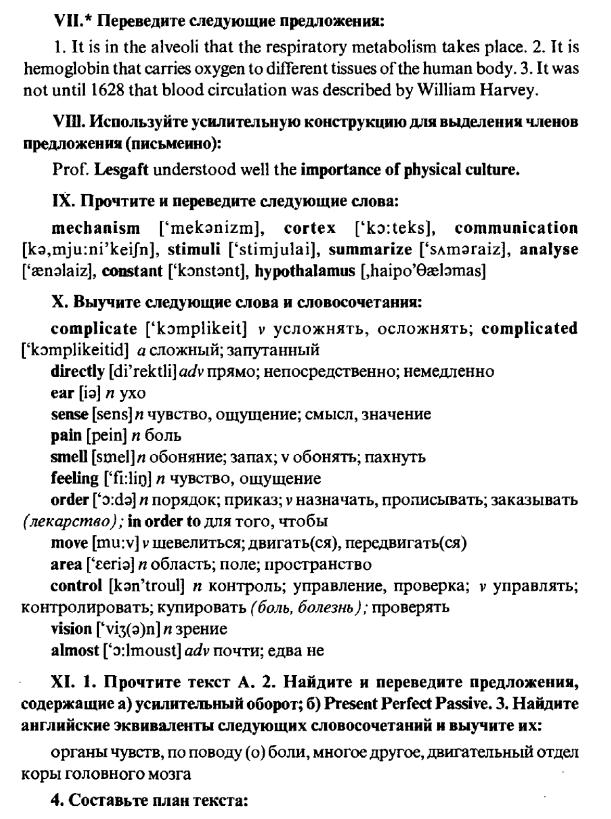
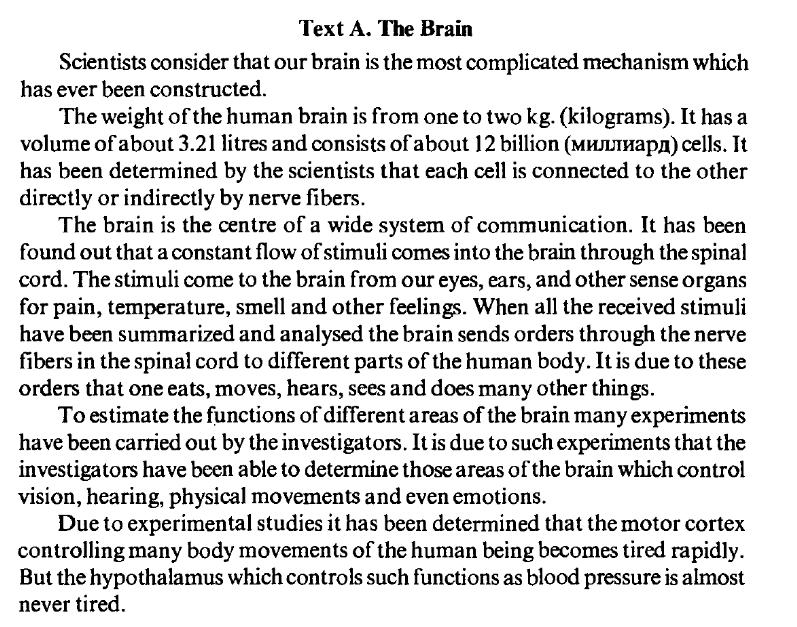
Alimentary tract - Травна система
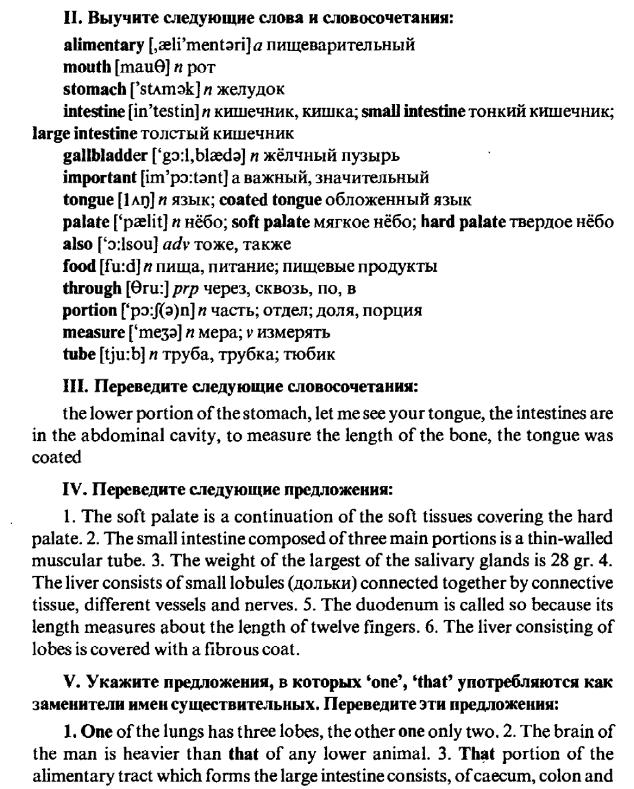

IMMUNITY - ІМУНІТЕТ
Exercise 1. Learn the following words:
-
invasion
indirect
resistance
immunity
immune
subsequent
virulent
antidote
neutralize
isolate
subcutaneous
capacity
natural
entirely
employ
lack
[in'veiʒ(ə)n]
[indi'rekt]
[re'zistəns]
[i'mјu:niti]
[i'mјu:n]
['sʌbsikwənt]
['virulənt]
[ænti'dəut]
['nјu:trəlaiz]
['aisəleit]
[sʌbkјu:'teiniəs]
[kə'pesɪtɪ]
['næt∫(ə)rəl]
[in'taɪəli]
[im'plɔɪ]
['læk]
вторгнення
непрямий
опір, протидія
імунітет
імунний
наступний
отруйний; вірулентний
антидот, протиотрута
нейтралізувати
ізолювати, відокремлювати
підшкірний
здібність; місткість
природний, натуральний
природний, натуральний
вживати, застосовувати, використовувати
нестача, брак; відсутність;
Exercise 2. Read and guess the meaning of the following words:
Microorganisms; infection; specific; natural; absolute; attack; permanent; protection; pathogenic; virulent; toxin; characteristic; symptom; chemical; antidote; antitoxin; neutralize; organs; bacterial; culture; result; formation; elements; part; protection; organism; leucocytosis; bacteria; phagocytes; reaction; vaccine; active; resistance; mechanism; active.
Exercise 3. Find corresponding equivalents:
-
infectious diseases
growth of microorganisms
the human organism
direct contact
resistance against infection
permanent protection
the characteristic symptoms
a chemical antidote
a sufficient amount
artificial immunity
штучний імунітет
організм людини
інфекційні захворювання
постійний захист
хімічний атидот
достатня кількість
прямий контакт
опір проти інфекції
характерні симптоми
ріст мікроогранізмів
Exercise 5. Read and translate the following word combinations into Ukrainian language:
White blood cells; to neutralize a toxin; result from direct contact; effects of a poison; to resist disease; physiological function; to produce immunity; a response to an infection; pathogenic microorganisms; capacity of resistance; a previous attack; permanent protection; subsequent infection; a chemical antidote; to suffer from diseases; bacterial cultures; to produce leucocytosis; to be surrounded by white cells; the spread of bacteria; to inject subcutaneously; to contribute to the treatment, to establish immunity.
Exercise 6. Match the words with their definitions:
-
disease
microorganism
infection
immunity
antidote
antitoxin
leucocytosis
vaccine
an antibody that neutralizes a toxin;
a drug or agent that counteracts or neutralizes the effects of a poison;
any organism, such as a bacterium, protozoan, or virus, of microscopic size;
the ability of an organism to resist disease;
any impairment of normal physiological function affecting all or part of an organism;
a suspension of dead, attenuated, or modified microorganisms for inoculation a gross increase in the number of white blood cells in the blood, usually as;
invasion of the body by pathogenic microorganisms
Exercise 7. Translate the following sentences. Define the type of Conditional Sentences:
1. If biopsy had revealed cancer cells in the lung, the patient would have been operated on.
2. If the temperature is extremely high viruses will not survive.
3. The gastric juice would contain much mucus if the examined patient had carcinoma.
4. The patient would not have developed severe anaemia, if he had not suffered profuse external bleeding because of a bad injury.
5. Had obstruction not been controlled, the patient would have undergone an emergency surgery.
6. Could the nurse carry out this procedure herself, she would not ask the doctor to help her.
7. Were I in your place, I should discontinue penicillin treatment.
8. Had the pain not radiated to the substernal area, the diagnosis of angina pectoris would have been excluded.
Exercise 8. Read and translate the text:
IMMUNITY
Infectious diseases are known to be caused by the invasion and growth of microorganisms in the human body. Infection may result from direct contact with patients or from one.
But the human organism is known to have a specific capacity of resistance against infection, which is called immunity, it being natural and artificial. Under various conditions it may be entirely lacking, it may be relative, rarely it may be absolute. A previous attack of an infectious disease produces a more or less permanent protection against its subsequent infection.
In the course of their growth in the body many microorganisms produce virulent poisons or toxins, they causing the characteristic symptoms of a particular disease. To meet the infection the cells of the body produce a chemical antidote which is specific for this particular infection and is known as an antitoxin. If the patient can produce a sufficient amount of this antidote to the toxins before the vital organs are injured recovery occurs. If the human body had not this capacity we should suffer from all infectious diseases.
If the toxin can be isolated from bacterial cultures and injected into men an artificial immunity can be produced which results from the formation of antitoxin.
The cellular elements of the tissues also take an active part in the protection of the organism against the infection. The presence of any infection usually produces leucocytosis and bacteria in the tissues are surrounded by white cells or phagocytes which prevent the spread of bacteria destroying them.
If the reaction against invading bacteria is insufficient, vaccines may be injected subcutaneously to produce a more active resistance of the protective mechanisms of the body. Vaccines are employed not only to contribute to the treatment of a disease, but to establish an active artificial immunity.
Exercise 9. Answer the following questions:
What is the main cause of infectious disease?
What may infection result from?
What specific capacity does the human organism have?
What are the main two types of immunity?
When do the microorganisms produce virulent poisons or toxins in the organism?
What specific substance do the cells of the body produce to meet the infection?
When can artificial immunity be produced?
What elements of the tissues also take an active part in the protection of the organism against the infection?
What is the main cause of leucocytosis?
What cells may also prevent the spread of bacteria?
Exercise 10. Find the appropriate sentence endings:
-
the invasion and growth of microorganisms in the human body.
the treatment of a disease.
leucocytosis.
virulent poisons or toxins.
a chemical antidote.
an artificial immunity can be produced the protection of the organism against the infection.
subcutaneously.
resistance against infection.
absolute.
Infectious diseases is caused by ...
But the human organism is known to have a specific capacity of ...
Under various conditions immunity may be entirely lacking, relative, ...
In the course of their growth in the body many microorganisms produce ...
To meet the infection the cells of the body produce ...
If the toxin can be isolated from bacterial cultures and injected into men...
The cellular elements of the tissues also take an active part in ...
The presence of any infection usually produces ...
If the reaction against invading bacteria is insufficient, vaccines may be injected ...
Vaccines are employed to contribute to ...
Exercise 12. Translate the following word combinations into English:
Вторгнення мікроорганізмів, виникати внаслідок прямого контакту, особлива здатність організму людини, природній імунітет, протидія інфекціям, постійний захист, перебіг хвороби, отруйні речовини, характерні симптоми, достатня кількість антидоту, страждати від інфекційних хвороб, викликати бути причиною) лейкоцитоз, перешкоджати розповсюдженню бактерій, вводити ліки підкожно, опір захисного механізму, сприяти успішному лікуванню.
Exercise 13. Put the verbs in brackets in the appropriate tense. Translate the sentences:
1. The bacteriologist was sure that the blood smear (to reveal) cocci.
2. If it (to be) a severe form of diphtheria it would be characterized by general prostration, cardiac depression and even anaemia.
3. The physician did not doubt that the smear culture (to reveal) diphtheria bacilli.
4. Had the temperature been accompanied by vomiting, headache and chills the diagnosis of diphtheria (to be) possible.
5. If Anton Leeuwenhock (1632-1723) ['liu:anhuk] (not to discover) the specific power (силу) of lenses, he should not have seen the world of microbes.
6. The patient's sclerae were yellow as if he (to have) jaundice.
7. Chronic gastritis ( not to be) so dangerous to life if the patient were not so young.
8. If the patient (to infect) with food poisons he would have suferred from acute abdominal pains.
9. If chemopharapy (not to discontinue) last week liver damage would have become severe.
VITAMINS - ВІТАМІНИ
Exercise 1. Learn the new words:
-
compound [ˈkɒmpaʊnd] – суміш, сполука
nutrient [ˈnjuːtrɪənt] - поживна речовина
amount [əˈmaʊnt] - кількість
sufficient [səˈfɪʃənt] - достатній
exception [ɪkˈsɛpʃən] - виняток
expose [ɪkˈspəʊz] - піддавати (чомусь - to)
fatty acid – жирна кислота
store - накопичувати
ingest [ɪnˈdʒɛst] - ковтати
diverse [daiˈvəːs] - різноманітний
protein [ˈprəʊtiːn] - протеїн, білок
carbohydrate [ˌkɑːbəʊˈhaɪdreɪt] - вуглевод
assist - допомагати, сприяти
heal - виліковувати, загоювати, заживати
wound [wuːnd] рана; поранення
performance [pəˈfɔːməns] - продуктивність
outer [ˈaʊtə] - зовнішній
deficiency [dɪˈfɪʃənsɪ] – нестача, дефіцит
Exercise 2. Form nouns with the help of the following suffixes, traslate the nouns into your language:
-ance(-ence): perform, assist, differ, maintain, appear, occur, disturb, resist
-ion: except, protect, direct, ingest, suggest, correct, infect, solute, palpate
Exercise 3. Translate the word combinations into your language:
Organic compound, sufficient quantity, single exception, essential nutrients, fatty acid, amino acid, water-soluble vitamins, fat-soluble vitamins, be stored in the fatty tissue, ingest frequently, excreted through the urine, diverse biochemical functions, maintain body tissues, immune system’s performance, outer cell membrane, deficiency disease, vitamin poisoning.
Exercise 4. Translate the sentences into your language paying attention to the use of modal verbs with active and passive infinitives:
1. Water-soluble vitamins must be used by the body at once.
2. Vitamin B12 is the only water-soluble vitamin that can be stored in the liver for many years.
3. You can develop health problems if you do not get enough vitamins.
4. Any woman who is pregnant should get enough folic acid.
5. High doses of certain vitamins can be poisonous.
6. Oil-soluble vitamins can be stored for long periods of time in the body's fatty tissue and the liver.
Exercise 5. Fill the gaps with the verbs from the box in the form of active or passive infinitive:
-
decrease produce include find administer take contain keep
1. Some vitamins can …by injection.
2. You may … a supplement that contains several needed nutrients in one tablet or capsule.
3. The potency of most vitamins may … by sunlight.
4. Vitamin supplements should … in a cool, dark place.
5. Excesses of isolated vitamins or minerals can … the same symptoms as deficiencies of vitamins or minerals.
6. Nutrients in supplement form should …for optimal health.
7. Natural supplements may …vitamins, minerals and other nutrients.
8. Supplements that are not labeled natural also may … artificial coloring, preservatives, sugars, and starch, as well as other additives.
Exercise 6. Read the text:
A vitamin is an organic compound required as a nutrient in tiny amounts by an organism. In other words, an organic chemical compound is called a vitamin when it cannot be synthesized in sufficient quantities by an organism, and must be obtained from the diet. If a molecule can be synthesized in the body, it is not a vitamin. The single exception to this rule is vitamin D which can be synthesized in the skin, but only when exposed to sunlight and Niacin (B3) which itself can be synthesized in the liver in small amounts. The term vitamin does not also include other essential nutrients such as minerals, fatty acids, or amino acids (which are needed in larger amounts than vitamins).
Vitamins are classified as either water-soluble or fat-soluble. There are 13 universally recognized vitamins: 4 fat-soluble (A, D, E, and K) and 9 water-soluble (8 B vitamins and vitamin C). Fat-soluble vitamins are stored in the body's fatty tissue, so they do not need to be ingested every day. Water soluble vitamins cannot be stored, with the exceptions of В12 and Folic Acid and must be ingested frequently for optimal health. They are easily excreted through the urine.
Vitamins have diverse biochemical functions. For example, vitamin A helps to develop and maintain body tissues such as bone and skin; it also helps the body’s vision, nervous system functioning, reproduction, and growth. The B vitamins are responsible for increasing the production of fats, proteins, and carbohydrates as well as assisting with metabolism, building red blood cells, and maintaining the protection of the nervous system. Vitamin C helps form tissues, cells, bones and teeth; heals wounds; and improves the immune system’s performance. Vitamin E protects the outer cell membranes from harm, thus assisting the immune system in fighting off diseases.
A diet naturally high in vitamins and minerals can be the best defense against many diseases. You can develop health problems (deficiency disease) if you do not get enough of a particular vitamin. But it is also important to remember that high doses of certain vitamins can cause vitamin poisoning.
Exercise 7. Answer the questions:
What vitamin can be synthesized in the body?
How are vitamins classified?
Which vitamins are fat-soluble?
Which vitamins are water-soluble?
How many vitamins are universally recognized?
Why is it unnecessary to ingest fat-soluble vitamins daily?
How are water-soluble vitamins excreted out of the body?
What functions do vitamins have?
What are B vitamins responsible for?
What are the functions of vitamin A?
What happens when an individual doesn’t get enough of a particular vitamin?
What can high doses of certain vitamins cause?
Exercise 8. Find words or word combinations in the text denoting the following:
a condition, such as pellagra, beriberi, or scurvy, produced by a lack of vitamins or other essential substances;
a condition of high storage levels of vitamins, which can lead to toxic symptoms;
an organic compound required as a nutrient in tiny amounts by an organism, which cannot be synthesized in sufficient quantities within the body;
a chemical compound whose molecules contain carbon;
a group of vitamins stored in the body's fatty tissue;
a group of vitamins which cannot be stored in the body.
Exercise 9. Translate the following word combinations into English:
Різноманітні біохімічні функції, викликати отруєння вітаминами, захищати зовнішню клітинну оболонку від пошкодження, органічна сполука, покращувати продуктивність імунної системи, розвивати авітаміноз, виділяти з сечею, допомогати підтримувати тканини тіла, у достатній кількості, єдиний виняток з цього правила, жирні кислоти та амінокислоти, потрібно споживати щоденно, необхідні поживні речовини, накопичуватися у жировій тканині, водорозчинні вітаміни, жиророзчинні вітаміни.
Exercise 10. Put questions to the underlined words:
Vitamin D can be synthesized in the body.
Water-soluble vitamins must be ingested frequently.
Vitamins have diverse biochemical functions.
High doses of certain vitamins can cause vitamin poisoning.
Vitamin C helps form tissues, cells, bones and teeth.
Vitamin E protects the outer cell membranes from harm.
Exercise 11. Translate the sentences into English paying attention to modal verbs with active and passive infinitives:
Печінка може накопичувати вітамін B12.
Вітамін В12 може накопичуватися у печінці.
Нам слід включати вітамінні добавки до нашого раціону.
Вітамінні добавки мають включатися до нашого раціону.
Не слід вживати жиророзчинні вітаміни щоденно.
Більшість вітамінів не можуть вироблятися організмом.
З яких джерел можна отримати вітаміни групи В?
За яких умов тіло може виробляти вітамін D?
Exercise 12. Define the following:
vitamin water-soluble vitamin fat-soluble vitamin deficiency disease vitamin poisoning
